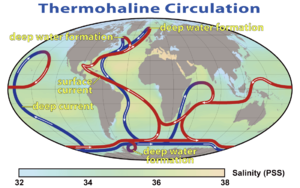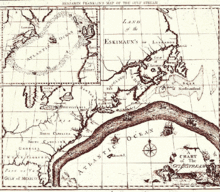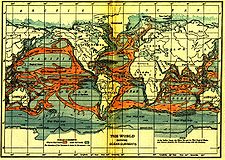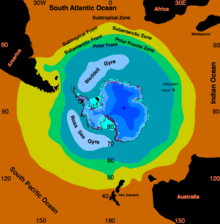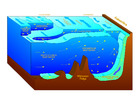- Oceanography
-
Oceanography (compound of the Greek words ωκεανός meaning "ocean" and γράφω meaning "to write"), also called oceanology or marine science, is the branch of Earth science that studies the ocean. It covers a wide range of topics, including marine organisms and ecosystem dynamics; ocean currents, waves, and geophysical fluid dynamics; plate tectonics and the geology of the sea floor; and fluxes of various chemical substances and physical properties within the ocean and across its boundaries. These diverse topics reflect multiple disciplines that oceanographers blend to further knowledge of the world ocean and understanding of processes within it: biology, chemistry, geology, meteorology, and physics as well as geography.
Contents
History
Humans first acquired knowledge of the waves and currents of the seas and oceans in pre-historic times. Observations on tides are recorded by Aristotle and Strabo. Early modern exploration of the oceans was primarily for cartography and mainly limited to its surfaces and of the creatures that fishermen brought up in nets, though depth soundings by lead line were taken.
Although Juan Ponce de León in 1513 first identified the Gulf Stream, and the current was well-known to mariners, Benjamin Franklin made the first scientific study of it and gave it its name. Franklin measured water temperatures during several Atlantic crossings and correctly explained the Gulf Stream's cause. Franklin and Timothy Folger printed the first map of the Gulf Stream in 1769-1770.[1][2]
When Louis Antoine de Bougainville, who voyaged between 1766 and 1769, and James Cook, who voyaged from 1768 to 1779, carried out their explorations in the South Pacific, information on the oceans themselves formed part of the reports. James Rennell wrote the first scientific textbooks about currents in the Atlantic and Indian oceans during the late 18th and at the beginning of 19th century. Sir James Clark Ross took the first modern sounding in deep sea in 1840, and Charles Darwin published a paper on reefs and the formation of atolls as a result of the second voyage of HMS Beagle in 1831-6. Robert FitzRoy published a report in four volumes of the three voyages of the Beagle. In 1841–1842 Edward Forbes undertook dredging in the Aegean Sea that founded marine ecology.
As first superintendent of the United States Naval Observatory (1842–1861) Matthew Fontaine Maury devoted his time to the study of marine meteorology, navigation, and charting prevailing winds and currents. His Physical Geography of the Sea, 1855 was the first textbook of oceanography. Many nations sent oceanographic observations to Maury at the Naval Observatory, where he and his colleagues evaluated the information and gave the results worldwide distribution.[3]
The steep slope beyond the continental shelves was discovered in 1849. The first successful laying of transatlantic telegraph cable in August 1858 confirmed the presence of an underwater "telegraphic plateau" mid-ocean ridge. After the middle of the 19th century, scientific societies were processing a flood of new terrestrial botanical and zoological information.
In 1871, under the recommendations of the Royal Society of London, the British government sponsored an expedition to explore world's oceans and conduct scientific investigations. Under that sponsorship the Scots Charles Wyville Thompson and Sir John Murray launched the Challenger expedition (1872–1876). The results of this were published in 50 volumes covering biological, physical and geological aspects. 4417 new species were discovered.
Other European and American nations also sent out scientific expeditions (as did private individuals and institutions). The first purpose built oceanographic ship, the "Albatros" was built in 1882. The four-month 1910 North Atlantic expedition headed by Sir John Murray and Johan Hjort was at that time the most ambitious research oceanographic and marine zoological project ever, and led to the classic 1912 book The Depths of the Ocean.
Oceanographic institutes dedicated to the study of oceanography were founded. In the United States, these included the Scripps Institution of Oceanography in 1892, Woods Hole Oceanographic Institution in 1930, Virginia Institute of Marine Science in 1938, Lamont-Doherty Earth Observatory at Columbia University, and the School of Oceanography at University of Washington. In Britain, there is a major research institution: National Oceanography Centre, Southampton which is the successor to the Institute of Oceanography. In Australia, CSIRO Marine and Atmospheric Research, known as CMAR, is a leading center. In 1921 the International Hydrographic Bureau (IHB) was formed in Monaco.
In 1893, Fridtjof Nansen allowed his ship "Fram" to be frozen in the Arctic ice. As a result he was able to obtain oceanographic data as well as meteorological and astronomical data. The first international organization of oceanography was created in 1902 as the International Council for the Exploration of the Sea.
The first acoustic measurement of sea depth was made in 1914. Between 1925 and 1927 the "Meteor" expedition gathered 70,000 ocean depth measurements using an echo sounder, surveying the Mid atlantic ridge. The Great Global Rift, running along the Mid Atlantic Ridge, was discovered by Maurice Ewing and Bruce Heezen in 1953 while the mountain range under the Arctic was found in 1954 by the Arctic Institute of the USSR. The theory of seafloor spreading was developed in 1960 by Harry Hammond Hess. The Ocean Drilling Project started in 1966. Deep sea vents were discovered in 1977 by John Corlis and Robert Ballard in the submersible "Alvin".
In the 1950s, Auguste Piccard invented the bathyscaphe and used the "Trieste" to investigate the ocean's depths. The nuclear submarine Nautilus made the first journey under the ice to the North Pole in 1958. In 1962 there was the first deployment of FLIP (Floating Instrument Platform), a 355 foot spar buoy.
Then, in 1966, the U.S. Congress created a National Council for Marine Resources and Engineering Development. NOAA was put in charge of exploring and studying all aspects of Oceanography in the USA. It also enabled the National Science Foundation to award Sea Grant College funding to multi-disciplinary researchers in the field of oceanography.[4]
From the 1970s, there has been much emphasis on the application of large scale computers to oceanography to allow numerical predictions of ocean conditions and as a part of overall environmental change prediction. An oceanographic buoy array was established in the Pacific to allow prediction of El Niño events.
1990 saw the start of the World Ocean Circulation Experiment (WOCE) which continued until 2002. Geosat seafloor mapping data became available in 1995.
In 1942, Sverdrup and Fleming published "The Ocean" which was a major landmark. "The Sea" (in three volumes covering physical oceanography, seawater and geology) edited by M.N. Hill was published in 1962 while the "Encyclopedia of Oceanography" by Rhodes Fairbridge was published in 1966.
Connection to the atmosphere
The study of the oceans is linked to understanding global climate changes, potential global warming and related biosphere concerns. The atmosphere and ocean are linked because of evaporation and precipitation as well as thermal flux (and solar insolation). Wind stress is a major driver of ocean currents while the ocean is a sink for atmospheric carbon dioxide.
Our planet is invested with two great oceans; one visible, the other invisible; one underfoot, the other overhead; one entirely envelopes it, the other covers about two thirds of its surface.Branches
The study of oceanography is divided into branches:
- Biological oceanography, or marine biology, is the study of the plants, animals and microbes of the oceans and their ecological interaction with the ocean;
- Chemical oceanography, or marine chemistry, is the study of the chemistry of the ocean and its chemical interaction with the atmosphere;
- Geological oceanography, or marine geology, is the study of the geology of the ocean floor including plate tectonics and paleoceanography;
- Physical oceanography, or marine physics, studies the ocean's physical attributes including temperature-salinity structure, mixing, waves, internal waves, surface tides, internal tides, and currents.
These branches reflect the fact that many oceanographers are first trained in the exact sciences or mathematics and then focus on applying their interdisciplinary knowledge, skills and abilities to oceanography.[5]
Data derived from the work of Oceanographers is used in marine engineering, in the design and building of oil platforms, ships, harbours, and other structures that allow us to use the ocean safely.[6]
Oceanographic data management is the discipline ensuring that oceanographic data both past and present are available to researchers.
Related disciplines
- Biogeochemistry
- Biogeography
- Coastal geography
- Environmental science
- Geophysics
- Glaciology
- Hydrography
- Hydrology
- Limnology
- Meteorology
- Physical geography
See also
- American Practical Navigator
- Anoxic event – Anoxic sea water
- Argo (oceanography)
- Atlantic Oceanographic and Meteorological Laboratory (AOML) (in the US)
- Bathymetric chart
- Ecological Forecasting
- Fleet Numerical Oceanography Center (USA)
- Freak wave
- List of ocean circulation models
- List of submarine topographical features
- List of Russian oceanographers
- Marine archaeology
- Marine current power
- Marine engineering
- Ocean colonization
- Ocean engineering
- Oceanographic Museum – Monaco
- Oceans Act of 2000
- Pollution
- Sea – contains list of world's seas
- Sea level
- Sea level rise
References
- ^ 1785: Benjamin Franklin's 'Sundry Maritime Observations'
- ^ Wilkinson, Jerry. History of the Gulf Stream January 01, 2008.
- ^ Williams, Frances L. Matthew Fontaine Maury, Scientist of the Sea. (1969) ISBN 0-8135-0433-3.
- ^ NOAA National Sea Grant Office (NSGO).
- ^ Impact from the Deep; October 2006; Scientific American Magazine; by Peter D. Ward; 8 Page(s)
- ^ Tom Garrison. "Oceanography: An Invitation to Marine Science" 5th edition. Thomson, 2005. Page 4.
Further reading
- Hamblin, Jacob Darwin (2005) Oceanographers and the Cold War: Disciples of Marine Science. University of Washington Press. ISBN 978-0295984827
- Steele, J., K. Turekian and S. Thorpe. (2001). Encyclopedia of Ocean Sciences. San Diego: Academic Press. (6 vols.) ISBN 0-12-227430-X
- Sverdrup, Keith A., Duxbury, Alyn C., Duxbury, Alison B. (2006). Fundamentals of Oceanography, McGraw-Hill, ISBN 0072826789.
- Lang, Michael A., Ian G. Macintyre, and Klaus Rützler, eds. Proceedings of the Smithsonian Marine Science Symposium. Smithsonian Contributions to the Marine Sciences, no. 38. Washington, D.C.: Smithsonian Institution Scholarly Press, 2009.
External links
- NASA Jet Propulsion Laboratory - Physical Oceanography Distributed Active Archive Center (PO.DAAC). A data center responsible for archiving and distributing data about the physical state of the ocean.
- Woods Hole Oceanographic Institution (WHOI). The world's largest private, non-profit ocean research, engineering and education organization.
- British Oceanographic Data Centre. A source of oceanographic data and information.
- NOAA Ocean and Weather Data Navigator. Plot and download ocean data.
- Freeview Video 'Voyage to the Bottom of the Deep Deep Sea' Oceanography Programme by the Vega Science Trust and the BBC/Open University.
- Glossary of Physical Oceanography and Related Disciplines by Steven K. Baum, Department of Oceanography, Texas A&M University
Atmospheric science · Environmental science · Geodesy · Geology · Geophysics · Glaciology
Hydrology · Oceanography · Physical geography · Soil scienceCategory · Portal Environmental science Related fields: Biology · Chemistry · Environmental design · Environmental economics · Environmental ethics · Environmental history · Environmental law · Environmental politics · Environmental sociology · Environmental studies · Physics · Pollution control · Sustainability · Waste management
Subfields of physical geography Biogeography · Climatology / Paleoclimatology · Coastal geography · Edaphology · Geomorphology · Glaciology · Hydrology / Hydrography · Landscape ecology · Limnology · Oceanography · Palaeogeography · Pedology · Quaternary science
 Categories:
Categories:- Applied and interdisciplinary physics
- Hydrology
- Oceanography
- Physical geography
- Greek loanwords
Wikimedia Foundation. 2010.

